ARM A53/A57/T760 investigated - Samsung Galaxy Note 4 Exynos Review
by Andrei Frumusanu & Ryan Smith on February 10, 2015 7:30 AM ESTGPU Performance
In the graphics department we're matching up Qualcomm's Adreno 420 versus the Mali T760MP6. The Adreno is running at 600MHz and is able to benefit from almost double the memory bandwidth at 25.6GB/s versus 13.2GB/s due to the Snapdragon's increased 128-bit memory interface. Let's look at how both compare in our overall benchmarks:

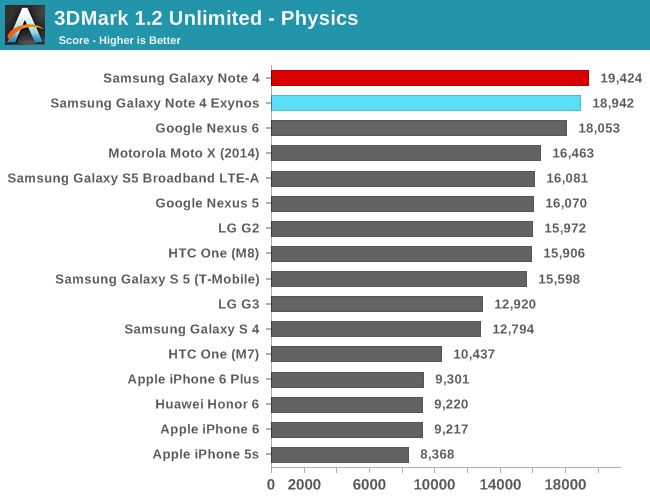
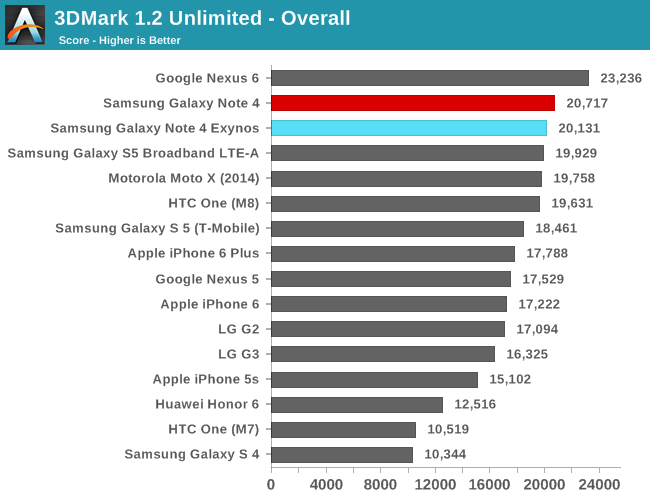
In 3DMark Unlimited the Exynos version comes just short of a few fps behind the Adreno 420. What is also surprising is that the Exynos 5433 performs much better in the physics score than I had anticipated; the same test on Huawei's SoCs limited the thread onto the little cores in the default settings giving mediocre performance results. However, it seems the A53 is performing much better and is able to match Qualcomm's offering now.
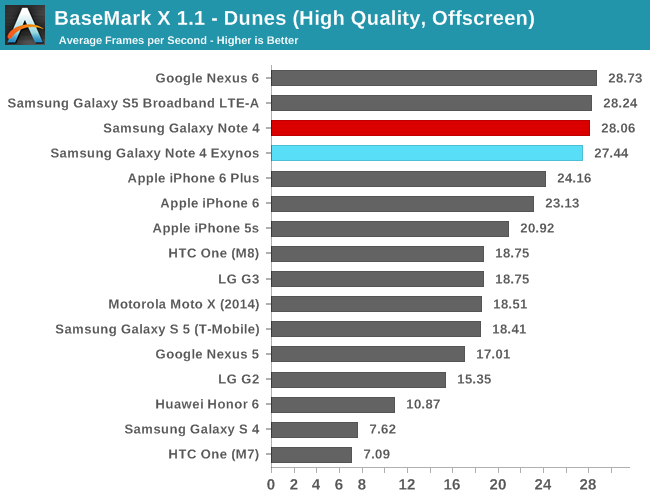
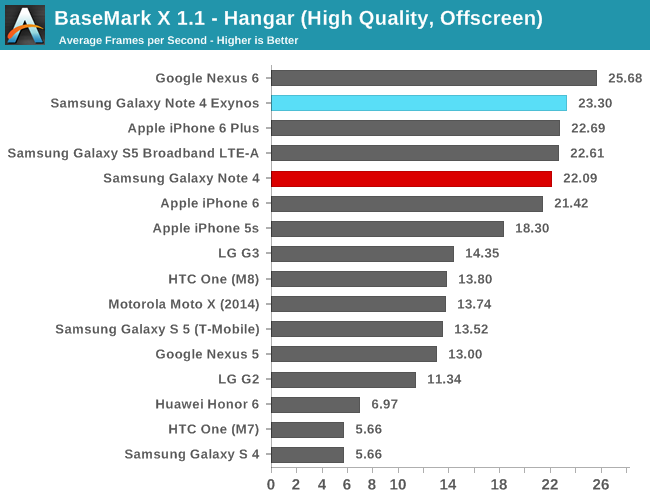
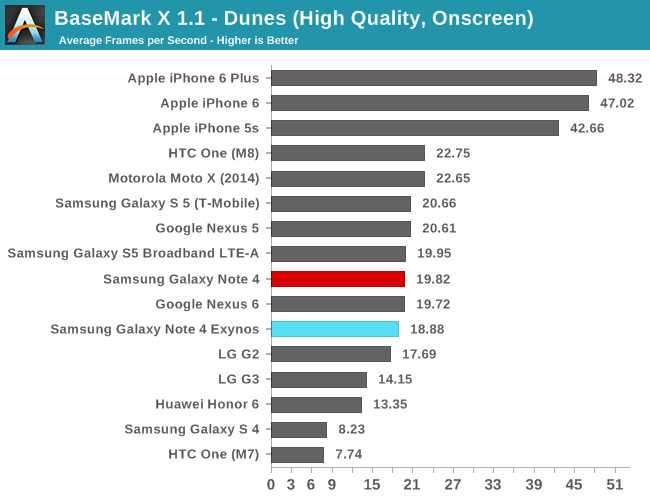

In BaseMark X 1.1, the Exynos is again neck-and-neck with the Snapdragon version. It loses by a slight margin in the Dunes benchmark while winning in the Hangar scenes by a similarly small margin. BaseMark X is again one of the benchmarks that can trigger the 700MHz state of the Mali GPU, offering higher performance at a much higher power draw depending on which scene is currently rendered on both tests.
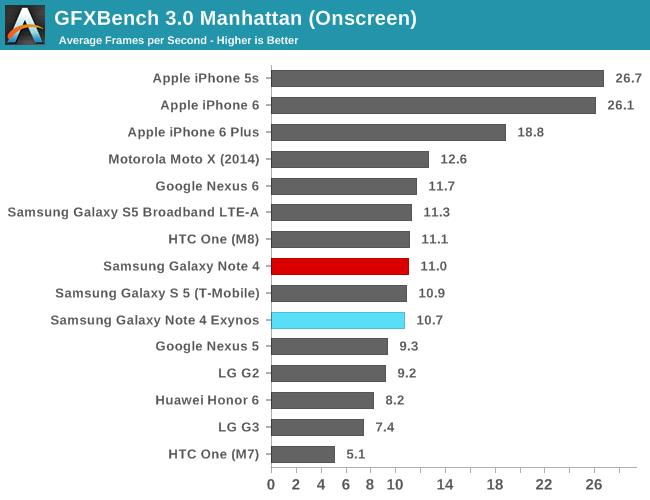
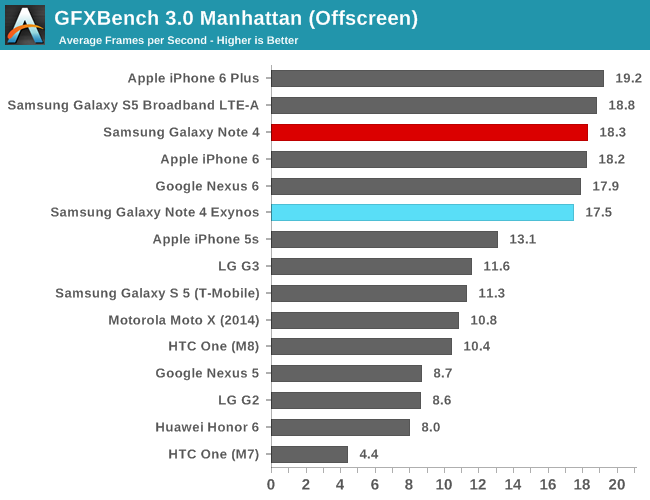
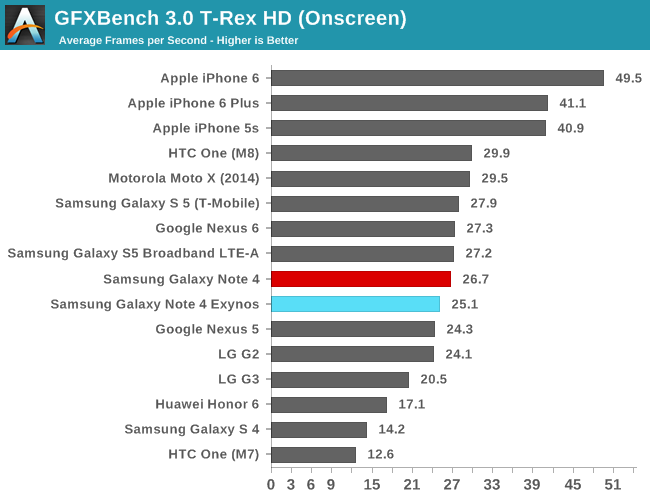
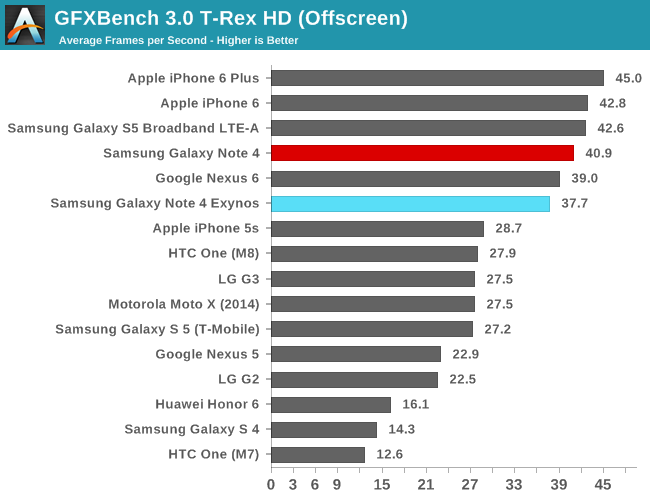
Again we continue to see the same pattern in GFXBench's scenario benchmarks, with the Exynos version lagging a few frames behind the Qualcomm GPU in both Manhattan and T-Rex, in both on-screen and off-screen results.
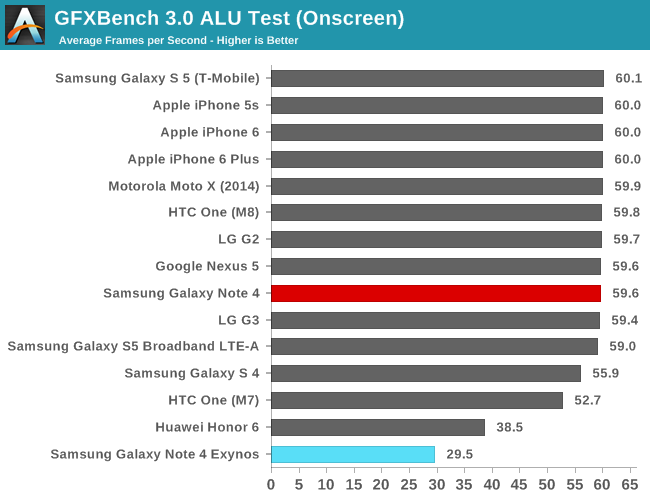

It's on the synthetic tests that we finally see some major deviation between the two architectures. ARM's Mali simply can't seem to keep up with the ALU throughput of Qualcomm's architecture. Both the Adreno 330 and 420 have a clear computational power advantage, exceeding even Imagination's PowerVR GPUs in the iPhones, leaving Mali strictly on the lower end of the performance spectrum.
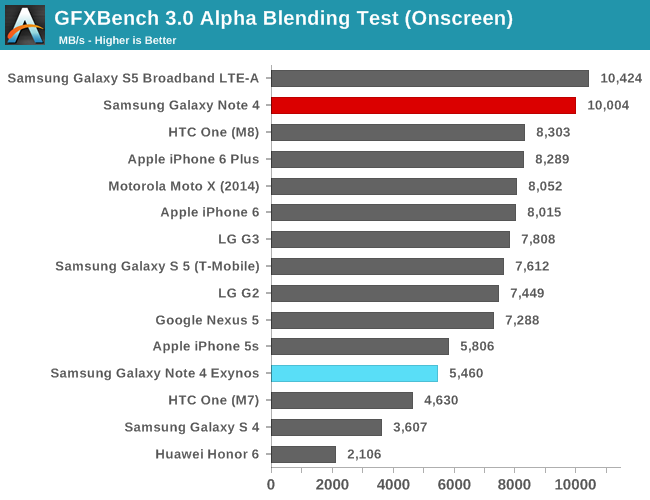
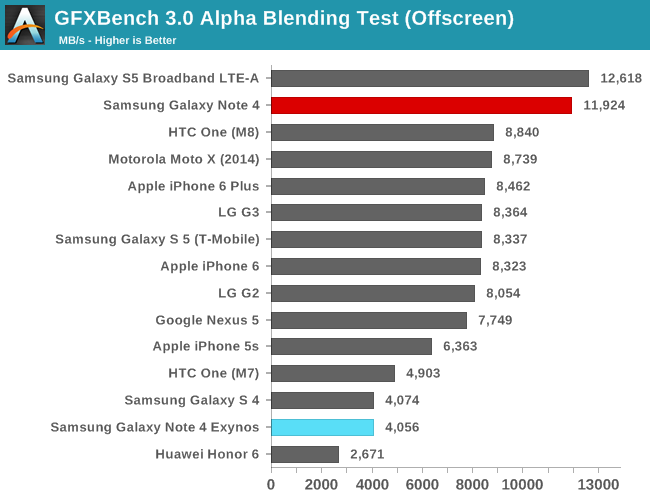
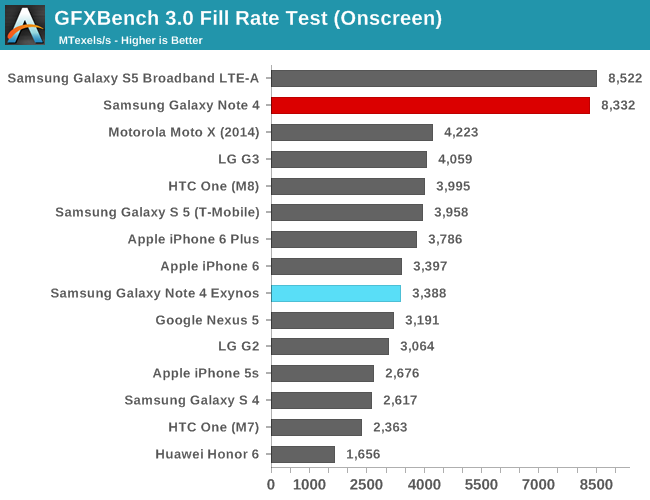
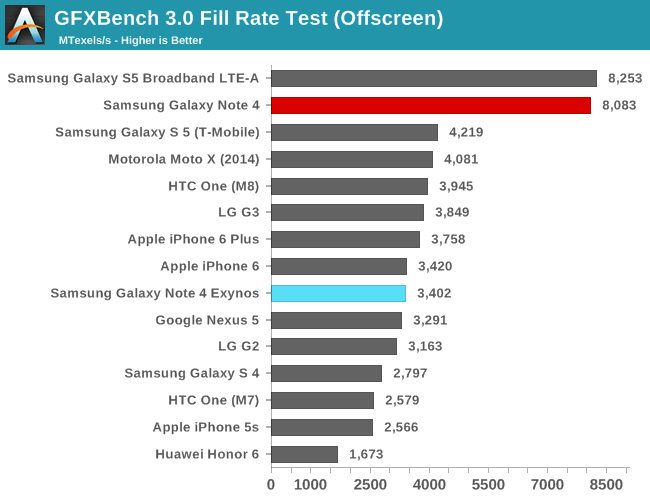
We see a similar situation in the Alpha Blending and Fillrate tests, as the Adreno offers 2-3x the throughput. Utilizing the extra memory bandwidth here seems to be key to the success of the Snapdragon 805's graphics performance.

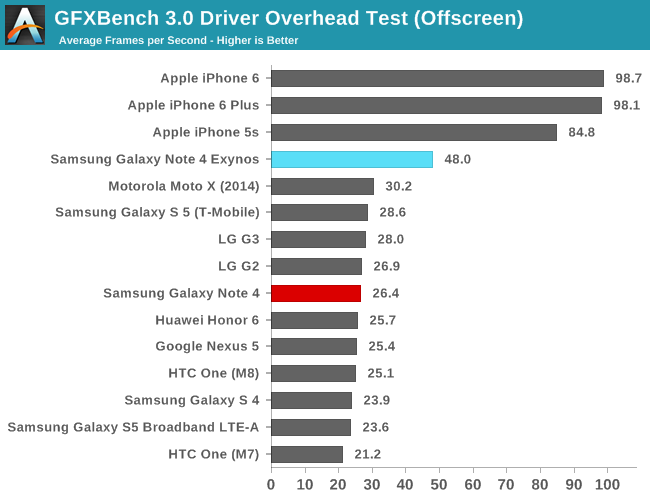
I've already mentioned the Driver Overhead score in the the more in-depth analysis of the T760. It's the first Android device to truly stand out from the rest of the crowd, finally making some progress into trying to catch up with Apple's excellent performance on iOS. Here's hoping more vendors concentrate on improving this metric in future driver updates.
I did some extensive power measurements on the Note 4 Exynos in this review, so naturally we're keen to see how this transforms into our battery benchmarks on the next page.










135 Comments
View All Comments
toyotabedzrock - Tuesday, February 10, 2015 - link
Dropping the browser tests is just stupid squared and wastes the opportunity to have Google and arm fix the inconsistency issue!Also your performance table for the a57 has an error for the PNG Comp ST.
toyotabedzrock - Tuesday, February 10, 2015 - link
To me it is clear why arm has a new core coming. The a57 was not designed to do 64bit well. If the system uses only 64bit apps it might get bottlenecked.lopri - Tuesday, February 10, 2015 - link
(pg. 6)BaseMark OS II Energy Efficiency test makes no sense to me. I get that perf/watt factor looks worse on the 5433, but why does the test consume more energy when run on big cores only, compared to when run on all 8 cores?
You have explained the performance degration part, but I am not sure whether you mentioned the reduced energy consumption part running 8 cores compared to 4 (big) cores. Running on 8 cores consume a little more than running on 4 LITTLE cores.
I wonder if that benchmark is trust-worthy?
Gigaplex - Tuesday, February 10, 2015 - link
Read through it again. They do comment on that and claim that the switching between big and little cores is likely adding so much overhead they're better off just staying on the big cores.Gigaplex - Tuesday, February 10, 2015 - link
If only there was an edit option... My original comment referred to reduced perf/watt in "8 core" mode rather than just the energy consumption.As to why running on all 8 uses less than only the big 4? It doesn't use them simultaneously, it can only use the big or the little, and it switches between them dynamically. Since the big cores get to idle/sleep when it's running on the little cores, it uses less power overall. This is the whole point of the big.LITTLE design. It's just a shame it doesn't actually work from a performance point of view.
lopri - Tuesday, February 10, 2015 - link
So that means the benchmark is limited to 4-threads, I assume? Stating that would have helped me understand it.Andrei Frumusanu - Wednesday, February 11, 2015 - link
I explained the nature of the XML test and that it was 3 threads:"The test is a good candidate because it offers a scaling load with three threads that put both a high load on some cores and let others exercise their power management states at the same time, definitely behavior you would see in day-to-day applications."
MikhailT - Tuesday, February 10, 2015 - link
Is it me, or does anybody else wish ARM would change their naming scheme?This single quote took 4-5 re-reads for me:
"As far as performance goes, ARM tells us that A53 can match A9 in performance at equivalent clock speeds. Given just how fast A9 is and just how small A53 is, to be able to match A9’s performance while undercutting it in die size and power consumption in this manner would be a feather in ARM’s cap, and an impressive follow-up to the A8-like performance of A7."
lopri - Tuesday, February 10, 2015 - link
Is the "special" frequency only available to ALU-heavy loads on Exynos really a special case? I noticed a similar behavior on S800, too. Adreno 320 should do max 450 MHz, but 99% of the time I see it maxes at 320 MHz. I thought something must be wrong at first, but when I ran benchmarks or other compute-heavy demos, it finally showed me 450 MHz. (not talking about cheating, obviously) It seems like a wide-spread practice.zodiacfml - Tuesday, February 10, 2015 - link
Not surprising outcome. All they need is produce this chip for the sheer number of cores which is popular in some but large markets. The chip is supposed to be good for better efficiency but we didn't see that.